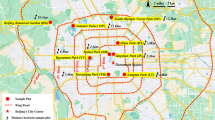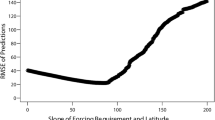Abstract
Temperate zone deciduous tree phenology may be vulnerable to projected temperature change, and associated geographical impact is of concern to ecologists. Although many phenology models have been introduced to evaluate climate change impact, there has been little attempt to show the spatial variation across a geographical region due to contamination by the urban heat island (UHI) effect as well as the insufficient spatial resolution of temperature data. We present a practical method for assessing climate change impact on tree phenology at spatial scales sufficient to accommodate the UHI effect. A thermal time-based two-step phenological model was adapted to simulate and project flowering dates of Japanese cherry (Prunus serrulata var. spontanea) in South Korea under the changing climates. The model consists of two sequential periods: the rest period described by chilling requirements and the forcing period described by heating requirements. Daily maximum and minimum temperature are used to calculate daily chill units until a pre-determined chilling requirement for rest release is met. After the projected rest release date, daily heat units (growing degree days) are accumulated until a pre-determined heating requirement for flowering is achieved. Model parameters were derived from the observed bud-burst and flowering dates of cherry tree at the Seoul station of the Korea Meteorological Administration (KMA), along with daily temperature data for 1923–1948. The model was validated using the observed data at 18 locations across South Korea during 1955–2004 with a root mean square error of 5.1 days. This model was used to project flowering dates of Japanese cherry in South Korea from 1941 to 2100. Gridded data sets of daily maximum and minimum temperature with a 270 m grid spacing were prepared for the climatological normal years 1941–1970 and 1971–2000 based on observations at 56 KMA stations and a geospatial interpolation scheme for correcting urban heat island effect as well as elevation effect. We obtained a 25 km-resolution, 2011–2100 temperature projection data set covering peninsular Korea under the auspices of the Inter-governmental Panel on Climate Change—Special Report on Emission Scenarios A2 from the Meteorological Research Institute of KMA. The data set was converted to 270 m gridded data for the climatological years 2011–2040, 2041–2070 and 2071–2100. The phenology model was run by the gridded daily maximum and minimum temperature data sets, each representing climatological normal years for 1941–1970, 1971–2000, 2011–2040, 2041–2070, and 2071–2100. According to the model calculation, the spatially averaged flowering date for the 1971–2000 normal is earlier than that for 1941–1970 by 5.2 days. Compared with the current normal (1971–2000), flowering of Japanese cherry is expected to be earlier by 9, 21, and 29 days in the future normal years 2011–2040, 2041–2070, and 2071–2100, respectively. Southern coastal areas might experience springs with incomplete or even no flowering caused by insufficient chilling required for breaking bud dormancy.
Similar content being viewed by others
References
Cesaraccio C, Spano D, Snyder L, Duce P (2004) Chilling and forcing model to predict bud-burst of crop and forest species. Agric For Meteorol 126:1–13
Choi J, Chung U, Yun JI (2003) Urban effect correction to improve accuracy of spatially interpolated temperature estimates in Korea. J Appl Meteor 42:1711–1719
Chung U, Choi J, Yun JI (2004) Urbanization effect on the observed change in mean monthly temperatures between 1951–1980 and 1971–2000 in Korea. Clim Change 66:127–136
De Melo-Abreu JP, Barranco D, Cordeiro AM, Tous J, Rogado BM, Villalobos FJ (2004) Modelling olive flowering date using chilling for dormancy release and thermal time. Agric For Meteorol 125:117–127
Han YH, Kim BH, Lee DL (1993) A study on the urban heat island in Pusan, Korea. J Korean Meteor Soc 29:205–216. (In Korean with English abstract)
Hansen J, Lawrence W, Easterling D, Peterson T, Karl T, Ruedy D, Sato M, Imhoff M (2001) A closer look at United States and global surface temperature change. J Geophys Res (D: Atmosphere) 106:23947–23963
Jones P, Kelly PM, Goodes CM, Karl T (1989) The effect of urban warming on the Northern Hemisphere temperature average. J Climate 2:285–290
Karl TR, Diaz HF, Kukla G (1988) Urbanization: its detection in the United States climate record. J Climate 1:1099–1123
Kim YH, Baik JJ (2002) Maximum urban heat island intensity in Seoul. J Appl Meteor 41:651–659
Kim WS, Ho C, Lee I, Lee EJ (2004) Earlier spring in Seoul, Korea. In: Proceedings of the second national climate change workshop, pp 168–173
Korea Meteorological Administration (1994) Guide to phenology observation, Government Publication 09200-74311-67-9407. p 131
Parmesan C, Yohe G (2003) A globally coherent fingerprint of climate change impacts across natural systems. Nature 421:37–42
Peterson TC, Huang A, Mckittrick DA, Gallo KP, Lawrimore J, Owen TW (1999) Global rural temperature trends. Geophys Res Lett 26:329–332
Root TL, Price JT, Hall KR, Schneider SH, Rosenzweig C, Pounds JA (2003) Fingerprints of global warming on wild animals and plants. Nature 421:57–60
Ryoo SB, Moon SE (1995) Detection of warming effects due to industrialization: an accumulated intervention model with an application in Pohang, Korea. J Appl Meteor 34:1466–1471
Seino H (1993) An estimation of distribution of meteorological elements using GIS and AMeDAS data. J Agric Meteorol (Japan) 48:379–383. (In Japanese with English abstract)
Yoon IH, Min KD, Kim KE (1994) A study on the meteorological characteristics of Taegu area and its application to the atmospheric dispersion modeling. II. Characteristic features of the urban heat island: case study. J Korean Meteor Soc 30:303–313. (In Korean with English abstract)
Yun JI, Choi J, Ahn JH (2001) Seasonal trend of elevation effect on daily air temperature in Korea. Korean J Agric For Meteor 3:96–104. (In Korean with English abstract)
Author information
Authors and Affiliations
Corresponding author
Rights and permissions
About this article
Cite this article
Chung, U., Jung, JE., Seo, HC. et al. Using urban effect corrected temperature data and a tree phenology model to project geographical shift of cherry flowering date in South Korea. Climatic Change 93, 447–463 (2009). https://doi.org/10.1007/s10584-008-9504-z
Received:
Accepted:
Published:
Issue Date:
DOI: https://doi.org/10.1007/s10584-008-9504-z




